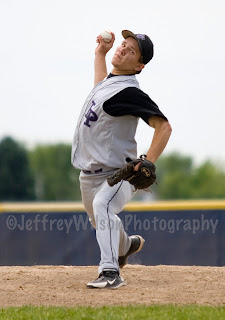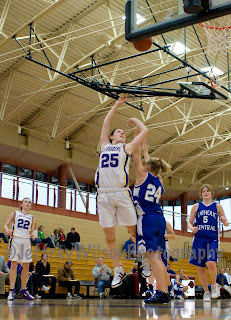
Adding feelings of drama, size, and strength to sports photos can make the difference between a snapshot and a powerful photograph. One of the best techniques for creating a dramatic sports image is to get as low as possible when taking the shot. Getting low and looking up at your subject makes the subject loom large in the photo. This is especially true when photographing youth sports. Here are photos from two high school games to illustrate the idea.
For the baseball shot, I kneeled behind the chain-link backstop screen, which was about 30 feet behind home plate, and to the left of the batter. By placing the front of the lens directly against the fence (with my fingers between the fence and lens to protect the lens glass), the chain-link disappears. The camera was just over two feet off of the ground. The final effect emphasizes that the pitcher is throwing down off the mound toward the camera. Keeping the aperture wide open blurs the background, focusing the attention on the pitcher.

To take the basketball shot, I sat on the floor about six feet from the endline and just to the left of the basket. I used manual focus, prefocusing on a point about 10 feet into the court from the baseline. I then placed the camera on the floor and tipped it upward to capture the view. This technique takes some practice, because I was shooting blind. A couple of test shots helped figure out the angles. (In cases like this, especially with a wide-angle lens, the autofocus would be more likely to lock on a background subject.)
Both photos were cropped after shooting (as described in an earlier post). I tried a couple of crops on the basketball photo before settling on this view — including the ball and basket emphasized the dramatic upward angle more than a shot that was cropped around the players only.
These principles can apply to other types of photos as well, including portraits and other types of action shots. Experiment with them, and don't be afraid to get down on the ground.
Tech info: Basketball: Canon XTi, Canon 28mm f/1.8 lens, 1/400 sec., f/2.5, ISO 1600.
Baseball: Canon XTi, Canon 70-200 f/2.8L lens, 1/1600 sec., f/2.8, ISO 100.
